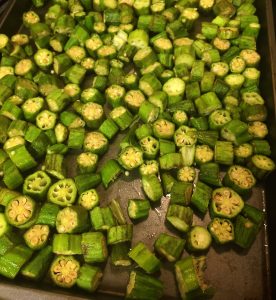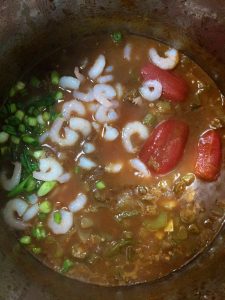Manale’s Seafood Gumbo Recipe
If you’re looking for authentic Creole fare, you can’t go wrong with a bowl of homemade gumbo. Just about every New Orleans family has their own recipe for gumbo, some of which have been passed down for generations. Thanks to the city’s immigrant legacy, the range of cultural influences any given Creole family may draw upon in their gumbo is boundless. A family with an Afro-French background might go heavy on the hot sauce and sop up the gumbo’s peppery juices with French bread as they eat. A family with a Native American and German background might make their gumbo with deer or duck and serve it over potato salad rather than rice. The various and constantly intersecting ethnic backgrounds of New Orleans families have made for an incredibly wide range of different dishes that can all be called gumbo.
Every family likes theirs best, of course. We all think our recipe is the real one. Ours is right. The beauty of Creole cooking, though, is that they’re all right. The widespread variation and personalization of Creole dishes are what makes Creole food so gosh darn special.
Today, I’m gonna walk you through one of my family’s recipes (since it’s the best of its kind, obviously). This gumbo recipe contains tomatoes — a very controversial ingredient! Some say gumbo has to have them, some say gumbo must NOT have them under any circumstances.
In any case, the tomatoes in this recipe are evidence of my family’s Italian roots. Most of my mom’s side of the family immigrated to New Orleans from Sicily in the late 1800s. They settled in an area in the back of the French Quarter called “Little Palmero,” often with an abundance of extended family members all living in one house. In 1913, my mom’s great-great uncle, Frank Manale, opened the doors to the family restaurant: Manale’s. One of Frank’s trusted nephews, Pascal Radosta (uncle/surrogate father to my grandpa), took over after Frank died in 1937. Pascal updated the name from just Manale’s to Pascal’s Manale Restaurant so that he would be represented too, as the new owner. I’ll tell you something though; my family still calls it Manale’s. I’m gonna keep calling it Manale’s. Probably force of habit.
Anyway, Manale’s got to be really popular under Pascal’s direction. By the fifties, the restaurant was famous. My grandpa, Papa, worked there pretty much his whole life. He moved in with Pascal’s family at age ten, after his father died, and started helping out as a delivery boy. He was promoted to maitre’d as soon as he was old enough (probably like 20), and became a fixture of the restaurant as it began to rise to prominence.
In it’s heyday Manale’s was a New Orleans nightlife staple, where people went when they were “steppin’ out.” Papa said the bar used to be so busy there wasn’t enough room to stand there and change your mind. He told me, “Super Bowl weekend the bar would be be so packed a broad could put her hand in her pocket and wind up with her hand in your pocket!” He was called the “keeper of the book” because he asked any famous people who came to eat or have drinks at Manale’s to sign this special leather-bound guest book he kept in a safe in the back. Marilyn Monroe even signed it once. Needless to say, Papa told me stories about his glory days at Manale’s that would make any grandkid’s eyes sparkle.
Papa’s last gig on the floor at Manale’s was Mardi Gras, 2015. He was 83 years old. EIGHTY-THREE YEARS OLD! Papa loved Manale’s, and he loved the hell out of his job. He passed away this year, to my great sadness. However, when I made the gumbo recipe I’m about to share with you I felt close to him again. I was reminded that he lives on through me as a part of my heritage, in my very genetic makeup. He also lives on through all the people who were there — the people who remember Papa’s gold-toothed grin greeting them from behind the maitre’d podium at Manale’s throughout its most iconic years. So, let’s celebrate Papa! I’m going to show you how to make a classic from the Manale’s menu: seafood gumbo. I think if Papa were here today he’d be glad you’re trying your hand at it. That is, making gumbo the right way.
Here’s what you’ll need:
- 2 pounds okra
- 3 tablespoons + 1/2 cup vegetable oil
- 1/2 cup flour
- 1 green bell pepper
- 1 onion
- 2 stalks celery
- 4 cloves garlic
- 2 quarts seafood stock
- 2 bay leaves
- 1 14.5 oz can crushed tomatoes
- 1 pound small peeled shrimp
- 1/2 pound lump crab meat
- 1/2 pound crab claw meat
- 1 bunch green onion
- 2 tablespoons file powder
- 3 tablespoons salt
- 1 tablespoon black pepper
- Louisiana style hot sauce (optional)
- 5 cups cooked rice
Before starting on the base of your gumbo, you first need to prepare the okra. Preheat your oven to 425 degrees. Cut 2 pounds of okra into ¼ inch slices, then toss them in a large bowl with 3 tablespoons of vegetable oil. Spread in one layer on a baking sheet and roast for five minutes. Carefully stir, then roast again for another five minutes. Your okra slices should be a slightly darker green color, but not cooked to the point they turn brown (see picture). Take the pan out of the oven and put it to the side – the okra will be used soon. But first, the unsung hero of the stew: the roux.
cooked to the point they turn brown (see picture). Take the pan out of the oven and put it to the side – the okra will be used soon. But first, the unsung hero of the stew: the roux.
There are about a thousand and one possible combinations of proteins and vegetables that might make their way into a Creole’s gumbo pot, but just about every gumbo begins with a roux. Made of equal parts fat and flour, roux acts as a thickening agent to create the heartiness that distinguishes gumbo from other watery soups. The rich, full-bodied quality of a steaming bowl of gumbo thickened with roux makes it the perfect comfort food to dig into as hot summer days turn to crisp autumn nights. Just the other day a Facebook friend of mine shared a post that read, “Can you smell the roux? That means it’s below 80 degrees in South Louisiana.”
To start your roux, combine ½ cup of vegetable oil with ½ cup of flour in a six-quart stockpot. Over medium to low heat, stir constantly. The initial mix will be a light caramel color, and it should start to bubble up as it heats.  The most crucial requirement of this step is that you stir continuously, because the heat will scorch your roux if it sits untouched for too long. You’ll know if this happens because it will have a distinct burning smell. No worries though — keeping a roux unburned is simple if you keep your eye on it! Even if your hand gets tired, keep stirring at least once every thirty seconds until the roux is a chocolate brown color. The time this takes may vary, but typically a roux will darken within a half hour. Mine took about twenty-five minutes.
The most crucial requirement of this step is that you stir continuously, because the heat will scorch your roux if it sits untouched for too long. You’ll know if this happens because it will have a distinct burning smell. No worries though — keeping a roux unburned is simple if you keep your eye on it! Even if your hand gets tired, keep stirring at least once every thirty seconds until the roux is a chocolate brown color. The time this takes may vary, but typically a roux will darken within a half hour. Mine took about twenty-five minutes.
When you’ve got your roux darkened to a chocolate brown, add in one chopped bell pepper, one chopped onion, two chopped stalks of celery, and 4 chopped cloves of garlic. Most gumbos use large chunks of vegetables, and that’s how I prefer mine, but if you want to chop your veggies up finely for a smoother stew that’s alright too. (One tip: I found that from this point on in the recipe, putting ingredients into a large bowl and then pouring them into the pot made for less splashing than adding them by hand.) Stir the vegetables so that the roux coats them like in the image to the right, and cook for 10 minutes.
Once your vegetable base has steeped in roux for ten minutes, you are ready to hydrate your gumbo. Add 2 quarts of seafood stock, 2 bay leaves, 1 14.5 oz can of crushed tomatoes, and the 2 pounds of okra you roasted beforehand. Bring to a boil, mix, then return to a heavy simmer. At this point, you finally get a little break. Phew! Simply let the mixture cook for one hour, stirring occasionally.
After your gumbo has stewed for an hour, add 1 pound of small, peeled shrimp and 1 bunch of chopped green onion. Cook for five minutes. Next, add your crab meat and 3 tablespoons of salt. The original recipe calls for ½ pound jumbo lump crabmeat and ½ pound claw crabmeat, but for the sake of my budget I went with a 16 oz can of Chicken of the Sea claw crabmeat. It’s probably better with fresh crab if you can get it, but I think the flavor of my gumbo still came out great with the canned stuff. Return to a simmer.
 While your gumbo simmers, add 2 tablespoons of file powder to a small bowl. Take one ladle of gumbo liquid from your pot and whisk it in with the file powder. The mix should thicken to create a slurry. Pour the slurry back into the gumbo pot and mix. This addition is an important finishing touch because the flavor of file is a feature consistent in the majority of gumbo’s many iterations. Just like you don’t really make a gumbo without a roux, you don’t really make a gumbo without file powder. I was expecting to have a tough time finding the stuff, but small bottles of it were actually available at my local Walmart in the “ethnic foods” section.
While your gumbo simmers, add 2 tablespoons of file powder to a small bowl. Take one ladle of gumbo liquid from your pot and whisk it in with the file powder. The mix should thicken to create a slurry. Pour the slurry back into the gumbo pot and mix. This addition is an important finishing touch because the flavor of file is a feature consistent in the majority of gumbo’s many iterations. Just like you don’t really make a gumbo without a roux, you don’t really make a gumbo without file powder. I was expecting to have a tough time finding the stuff, but small bottles of it were actually available at my local Walmart in the “ethnic foods” section.
With the addition of file powder, your gumbo has finally come to life. Season with salt, pepper, and hot sauce to taste. Serve over rice and congratulate yourself — you just made yourself a pot of authentic New Orleans gumbo. If you’d like to dine in the spirit of Papa or the Big Easy, enjoy your meal with good friends, lively conversation, and a cocktail or two. Buon appetito!